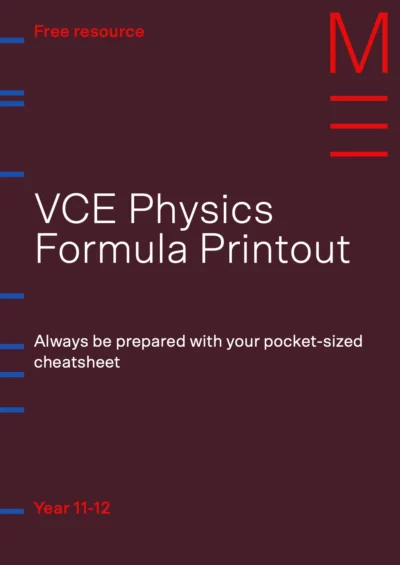Welcome to Matrix Education
To ensure we are showing you the most relevant content, please select your location below.
Select a year to see courses
Learn online or on-campus during the term or school holidays
Learn online or on-campus during the term or school holidays
Learn online or on-campus during the term or school holidays
Learn online or on-campus during the term or school holidays
Learn online or on-campus during the term or school holidays
Learn online or on-campus during the term or school holidays
Learn online or on-campus during the term or school holidays
Learn online or on-campus during the term or school holidays
Learn online or on-campus during the term or school holidays
Learn online or on-campus during the term or school holidays
Select a year to see available courses
Science guides to help you get ahead
Science guides to help you get ahead
Test your knowledge of VCE Physics Units 1 and 2 and see how ready you are for Year 12 with these 10 quick questions!

Join 75,893 students who already have a head start.
"*" indicates required fields
Related courses

Join 8000+ students each term who already have a head start on their school academic journey.
VCE Physics Units 1 and 2 are the foundation for everything you’ll learn in Year 12. Now is the time to build strong skills and knowledge, before the pressure ramps up. You should take this year seriously so you’re ready for what Year 12 brings!
In Year 11, you’ll start to learn key topics like:
These introduce important ideas like how waves and particles behave, how energy moves, and how forces shape our world. These concepts are the building blocks for the more advanced Year 12 Physics topics like electromagnetism, quantum mechanics, and advanced mechanics.
Even if you’re not aiming for a Science degree, Physics helps you understand real-world issues that are involved in many other degrees. You’ll learn what’s behind climate change, medical breakthroughs, and technology.
If you’re already thinking ahead, check out our VCE Physics Study Guide: How to Ace Your Exam for tips on staying ahead and boosting your marks.
Ready to see if you’re ready for your next SAC? Here are 10 quick questions to test your knowledge of Units 1 and 2!
Before you dive into the questions, grab this handy formula sheet. It’s the perfect pocket-sized reference to help you and boost your accuracy as you practise.
Ace your next exam with all the essential formulas at your fingertips Fill out your details below to get this resource emailed to you. "*" indicates required fields
Grab your free VCE Physics Formula Sheet!

Grab your free VCE Physics Formula Sheet!
1. A light ray passes from air (n = 1.00) into water (n = 1.33) at an angle of incidence of 30°. Calculate the angle of refraction. (3 marks)
2. An object emits radiation with a peak wavelength of 2.90 μm. Calculate its temperature using Wien’s Law: \(\lambda_{max} T = 2.898 \times 10^{-3}\). (2 marks)
3. Calculate the energy required to heat 500 g of water from 25°C to 75°C. Assume \( c_{water} = 4.18 J/g/K \). (2 marks)
4. A sample of radioactive material has a half-life of 5 years. If the initial mass is 80 g, how much remains after 15 years? (2 marks)
5. Write the nuclear decay equation for the beta-minus decay of carbon-14. (2 marks)
6. A 12 V battery is connected to two resistors, \(R_1 = 4 \Omega\) and \(R_2 = 6 \Omega\), arranged in series. Calculate:
a. The total resistance (1 mark)
b. The current in the circuit (2 marks)
7. Explain why household circuits are generally connected in parallel rather than in series. (3 marks)
8. A 100 W lightbulb operates on 230 V DC. Calculate the current through the bulb and the resistance of the filament. (3 marks)
9. A ball is thrown vertically upwards with an initial velocity of 15 m/s. Calculate:
a. the time it takes to reach its highest point. (1 mark)
b. the maximum height reached. (2 marks)
10. A 2.0 kg object moving at 6.0 m/s collides elastically with a stationary object of mass 3.0 kg. The first object rebounds at 1.2 m/s.
a. Calculate the velocity of the 3.0 kg object after the collision. (2 marks)
b. Is the collision elastic? Justify your answer. (2 marks)
Want Band 6 Physics resources?
Learn from expert HSC Physics teachers and structured lessons. See why 8000+ join Matrix each term.
1. Calculate the angle of refraction (3 marks)
Using Snell’s Law:
\(n_1 \sin \theta_1 = n_2 \sin \theta_2\)
\(1.00 \times \sin(30^{\circ}) = 1.33 \times \sin \theta_2\)
Solving for the unknown angle, we find \(\theta_2 = 22^{\circ}\)
2. Object temperature using Wien’s law (2 marks)
Wien’s law states: \(\lambda_{max} T = 2.898 \times 10^{-3}\)
\(T = \frac{2.898 \times 10^{-3}}{\lambda_{max}}\)
Hence the temperature is 1000 K.
3. Energy to heat water (2 marks)
The equation to calculate the required heat is: \(Q = mc \Delta T\).
The mass is given in units of grams, which matches the units of specific heat capacity; the increase in temperature is the same when expressed in Kelvin as in Celsius. Hence:
\(Q = mc\Delta T = 500 \times 4.18 \times (75 – 25)\)
The heat required is 104,500 J, or 104.5 kJ.
4. Remaining radioactive material (2 marks)
After three half-lives, the remaining amount is one-eighth of the original value.
There are 10 grams left.
5. Beta-minus decay (2 marks)
In beta-minus decay, the products must include the electron and antineutrino:
\(^{14}_6 C \rightarrow ^{14}_7 N + e^- + \bar{\nu}\)
6. Resistors in series (3 marks)
a. Resistances add together in series for a total \(R = 10 \Omega\)
b. The current through the entire circuit can be determined using Ohm’s Law: \( I = \frac{V}{R} = \frac{12}{10} = 1.2 \)
The current through the circuit is 1.2 A.
7. Household circuits (3 marks)
Parallel circuits allow each device to operate independently, with a consistent voltage across each device even when others are connected or removed. A fault in one branch of the circuit does not affect the others. Overall, parallel circuits are more reliable and deliver more power to connected appliances than series circuits.
8. Lightbulb calculations (3 marks)
a. The power dissipated by a circuit component is given by \(P=IV\)
\(I = \frac{P}{V} = \frac{100}{230} = 0.44\)
The current is 0.44 A.
b. Resistance can be calculated using Ohm’s Law.
\(R = \frac{V}{I} = \frac{230}{0.44} = 520\)
The resistance is 520 \(\Omega\).
9. Equations of motion (3 marks)
a. Taking upwards as positive, the initial velocity is 15 m/s and the acceleration is -9.8 m/s2.
At the highest point of its motion, the ball reaches a velocity of zero. Hence using \(v = u + at\)
\(0 = 15 – 9.8t\)
This gives the time of flight as 1.53 seconds.
b. Using the same logic as before, we can solve for the displacement travelled when it reaches a velocity of zero. This will be the highest point. \(v^2 = u^2 + 2as\)
\(0 = 15^2 – (2 \times 9.8 \times s)\)
This gives a maximum upwards displacement of 11.5 metres.
10. Momentum and collisions (4 marks)
a. We use the conservation of momentum equation: \(m_1 u_1 + m_2 u_2 = m_1 v_1 + m_2 v_2\)
We will take object 1’s initial velocity to be positive. After it rebounds, the new velocity will be negative.
Knowing both masses, and the fact that object 2 is initially stationary:
\(2.0 \times 6.0 + 3.0 \times 0 = 2.0 \times -1.2 + 3.0 \times v_2\)
Solving for the final velocity of object 2, we find \(v_2 = 4.8 m/s.\)
b. The collision is elastic if kinetic energy is conserved, that is, if:
\(\frac{1}{2} m_1 u_{1}^{2} + \frac{1}{2} m_2 u_{2}^{2} = \frac{1}{2} m_1 v_{1}^{2} + \frac{1}{2} m_2 v_{2}^{2} \)
The initial kinetic energy is: \(\frac{1}{2} \times 2.0 \times 6.0^2 + \frac{1}{2} 3.0 \times 0^{2} = 36 J\)
The final kinetic energy is: \(\frac{1}{2} \times 2.0 \times (-1.2)^2 + \frac{1}{2} 3.0 \times 4.8^{2} = 36 J\)
Hence the collision is elastic.
Year 11 VCE Physics Units 1 and 2 is an important step toward your future. By working hard now, you’ll prepare yourself to succeed in Year 12 and beyond. It’s your chance to build the knowledge and skills you’ll need for both academic success and careers that rely on Physics.
Learn anytime, anywhere with Matrix+ online
Access theory lesson videos, expert teachers and proven resources. Trusted by 8000+ students each term.
Written by Matrix Education
Matrix is Sydney's No.1 High School Tuition provider. Come read our blog regularly for study hacks, subject breakdowns, and all the other academic insights you need.© Matrix Education and www.matrix.edu.au, 2025. Unauthorised use and/or duplication of this material without express and written permission from this site’s author and/or owner is strictly prohibited. Excerpts and links may be used, provided that full and clear credit is given to Matrix Education and www.matrix.edu.au with appropriate and specific direction to the original content.